Quality of the Environment in Japan 1996
Part II
Section 4. Policies on Waste and Recycling
As socioeconomic activities have developed and become charac-terized by mass-production,mass-consumption and mass disposal,the total volume and variety of waste have increased. Landfill capacity is becoming strained. At each stage of activities from resource extraction to waste disposal, more and more burden on the environment is gener-ated. Therefore,a socioeconomic system which can attain a state of sus-tainable development must be developed,by enhancing cycling of mate. rial within the socioeconomic system. Based on this awareness,the fol lowing basic way of thinking concerning waste product and recycling countermeasures was first clarified in the Basic Environment Plan of the government as a whole. First,generation of waste should be re-duced. Second,reuse of used products should be promoted. Third. waste should be recycled into raw materials. Where the technological level makes such recycling difficult or not economically feasible, heat recov-ered from incineration should be used as an energy source, taking suffi-cient measures to prevent adverse environmental effects. Finally, waste that is generated should be disposed of in an appropriate manner.
Countermeasures to recycle all waste products are being carried out in line with this Basic Environment Plan.
Fig. 5-4-1 Trend in Volume of Domestic Waste Generated
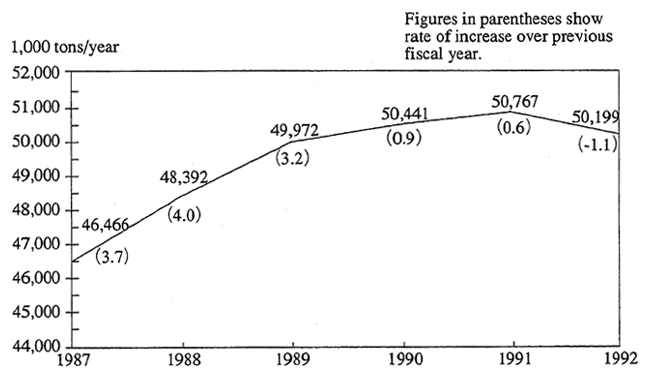
Source: Ministry of Health and Welfare
Fig. 5-4-2 Trend in Total Volume of Industrial Waste Generated
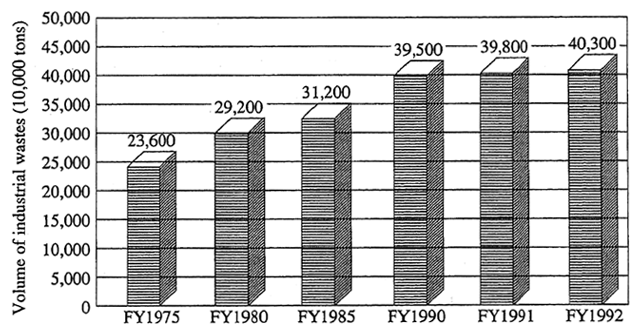
Source: Ministry of Health and Welfare
Fig. 5-4-3 Trend in Remaining Capacity and Remaining Number of Years for Domestic Waste Disposal Sites
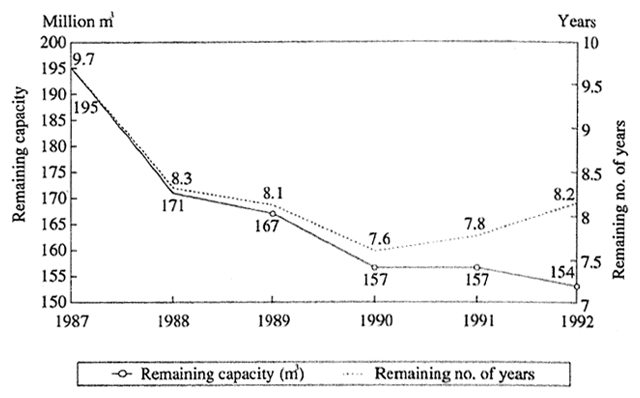
Source: Ministry of Health and Welfare
Fig. 5-4-4 Trend in Recycling Rates of Domestic Waste
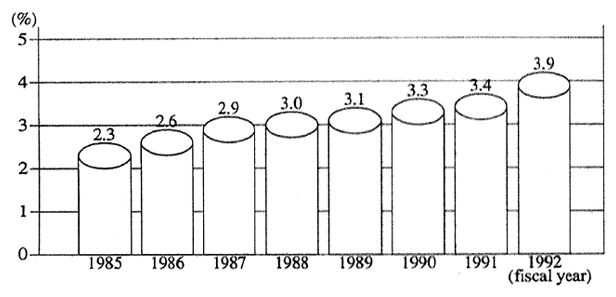
Note : Recycling rate (%) (Rt/T)ラ100, where Rt stands for the amount of resouces re-covered from the treatment process, and T stands for the amount of waste trented.
Source:Japan's Waste Disposal,Ministry of Health and Welfare
Table 5-4-1 Reserve Capacity of Final Landfill Sites for Industrial Waste, and Reserve Capacity in Years (as of April 1993)

Notes:1. The Tokyo Metropolitan Area refers to Ibaragi,Tochigi,Gunma,Saitama, Chiba,Tokyo and Kanagawa Prefectures. The Kinki Region refers to Mie, Shiga,Kyoto,Osaka,Hyogo,Nara and Wakayama Prefectures.
2. The disposal volume required for industrial wastes in the Tokyo Metropolitan Area and the Kinki Region is calculated as 89 million ラ28.9% (Tokyo Metropoli-tan Area) and 16.0% (Kinki Region) (ratios to the fiscal year 1992 waste volume).
3. Years of reserves = Reserve capacity/Disposal volume required (assuming that the calculation ratio of tons to m3 equal to 1).
4. Figures in parentheses show the survey results for the previous fiscal year.
1. Reducing Waste Generation
Apart from promotion of recycling,measures shall be taken to discourage the production and sales of disposable goods and excessive packaging practices,and to encourage consideration in design,manufac-turing and distribution of products such as making them more durable. Likewise,people shall be encouraged to reconsider their lifestyle and to refrain from using disposable goods,and popularization and education contributing to these efforts have been carried out. Economic measures, such as collection of fees in accordance with the volume of household waste,shall be utilized to encourage waste reduction,and surveys are being conducted to this end. Other measures include promotion of na-tional campaigns to reduce waste,and the dissemination of information on waste disposal.
As for controlling the generation of toxic waste,consideration in product design and manufacturing shall be promoted.
2. Promoting Recycling
(1) Promotion of Reuse
The Environment Agency,the Ministry of Finance,the Ministry of Health and Welfare, the Ministry of Agriculture, Forestry and Fisher-ies and the Ministry of International Trade and Industry have cooper-ated in starting surveys and studies to promote the reuse of packaging.
(2) Collection and Regeneration
The Law for the Promotion of Utilization of Recyclable Re-sources, which has been enacted in 1991, set the basic directions for the planned and comprehensive use of recyclable materials. Under this law inter-agency measures were established to promote the use of recycla-ble materials in specially designated industries (paper mills, glass con-tamer producers, construction); the use of structure and materials se-lections conducive to the use of recyclable materials for Category One Products (automobiles, air conditioners, televisions, washing machines, refrigerators and twenty electrically operated items using nickel-cadmium cells); the labeling of Category Two Products (soft drink con-tainers made of aluminum or steel; PET bottles and nickel-cadmium cells) for the ease of differential waste collections; and the use of speci-fied by-products (iron and steel slug, coal ash, soil and sand, cement blocks, asphalt-concrete blocks, lumber) as recyclable materials.
To reduce environmental burden, it is necessary to promote the regeneration of resources from waste and the collection and reuse of re-cyclable resources.
In the Industrial Structure Council, concerning the waste prod-ucts of ten industry types and 22 items of general waste products, guidelines concerning the waste product treatment and resource recla-mation that a business should adhere to, such as the establishment of re-cycling targets and the preparation of recovery routes, were presented and, in addition to inspecting the state of their progress, the guidelines were partially revised in March 1996.
Furthermore, support in the area of financing and taxation was implemented based on the Law for Temporary Measures Concerning Rationalization of Energy Use and the Promotion of Resource Recycling Business and related to technical development and the introduction of equipment to promote recycling.
InRecycling Promotion Monthin October every year, in order to obtain the understanding and cooperation of the citizens regarding recycling, the Economic Planning Agency, the Environment Agency, the Ministry of Finance, the Ministry of Health and Welfare, the Minis-try of Agriculture, Forestry and Fisheries, the Ministry of International Trade and Industry, the Ministry of Transport and the Ministry of Con-struction, which are the ministries and agencies concerned with recy-cling, implement extensive popularization and educational activities, and in FY 1995 various Symposia were also held and awards were given to persons of merit in the area of promoting recycling.
In the Environment Agency, support was carried out through the Japan Fund for Global Environment with respect to recycling activi-ties by private groups, the creation and distribution of materials for the popularization of, and education concerning, recycling and the promo-tion of various types of survey research related to recycling. In the Min-istry of International Trade and Industry, in order to promote recycling and the control of the generation of waste, the development of chemical recycling technology was carried out.
in the Economic Planning Agency, support was given to recy-cling activity groups through the regional promotion conferences of the citizens' movement to conserve resources established in each prefec-ture.
In the Ministry of Health and Welfare, various types of educa-tional activities were cairried out in order to promote the reclamation, reuse and reduction of waste, such as deciding on a newWaste Reduc-tion Promotion Weekin th week of 30 May to 5 June beginning in 1993, in addition to subsidizing projects related to the construction of, and organization-building for, a route to make garbage a resource in or-der to promote the provision of a structure in local government entities.
Furthermore, in order to provide for still more promotion of recy-cling, research concerning appropriate economic methods related to re-cycling was moving forward in each relevant ministry and agency. In the Environment Agency, further study has progressed based on the Economic Measures for Recycling Study Meetingsreport publicly an-nounced in April 1994. In the Ministry of Construction, concerning con-struction waste, which can be expected to increase still more due to the expansion of public investment, based on disseminating information about controlling its generation, promoting its reuse, and appropriately disposing of it, besides carrying out guidance with respect to orderers and builders, and in addition to implementing a survey in order to follow up on the Action Plan for Construction By-product Countermeasures (Recycle Plan 21) decided on in April 1994, comprehensive measures such as promoting research and development and implementing the Re-cycling Model Construction were implemented.
(3) Enforcement of Law for Promotion of Sorted Collection and Recycling of Containers and Packaging
Concerning containers and packaging, which comprises the ma-jority of general waste (Fig. 5-4-5) and can technically be reused as a re-claimed resource, theLaw for Promotion of Sorted Collection and Re-cycling of Containers and Packaging was promulgated on 16 June 1995 (Fig. 5-4-6), and a Cabinet Order and Ministerial Ordinance was enacted on 15 December 1995 in order to provide for di promotion of the con-struction of a system to promote sorted collection by cities, towns and villages and recycling by businesses, and thus to attain the appropriate treatment of waste and the effective reuse of resources. Furthermore, on 25 March 1996, based on Article 3 of this law, a basic policy was de-cided upon and promulgated concerning promotion of the sorted collec-tion of container packaging waste and the recycling of items conform-ing to the classification standard.
Fig. 5-4-5 Ratio of Container and Package Waste to All Domestic Waste
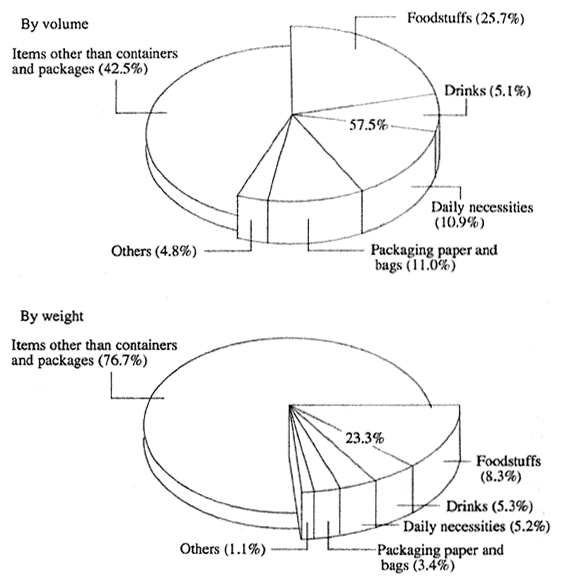
Source: Ministry of Health and Welfare
5-4-6
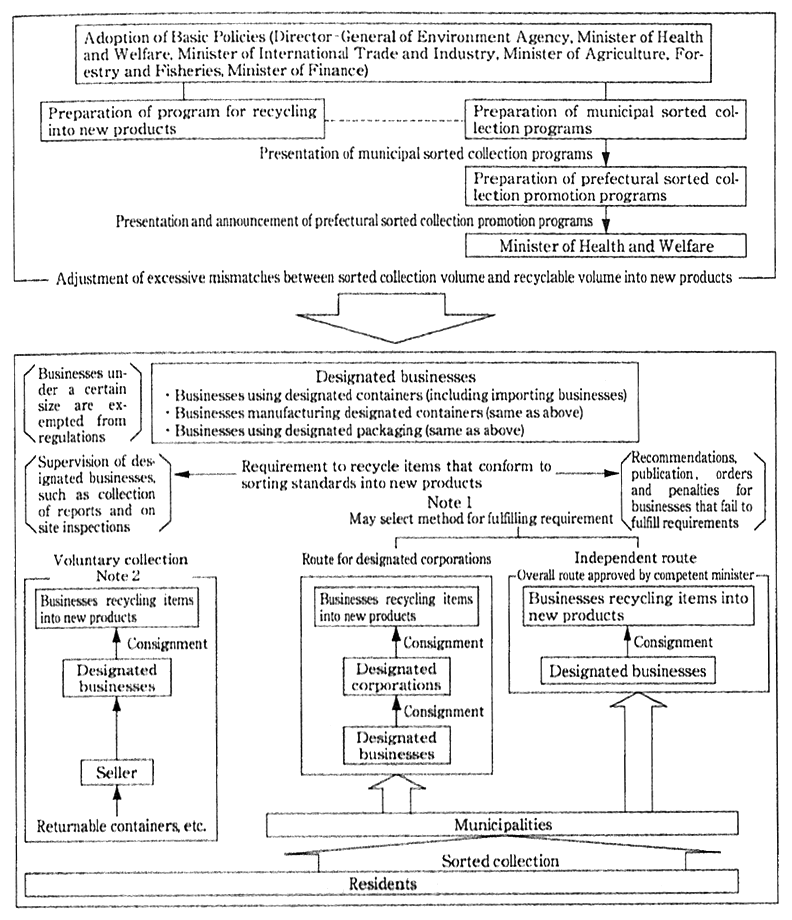
Note:1. Those items that arc stipulated in the competent ministerial ordinances as being transferred for either payment or non-payment, and that are not re-quired to be recycled Into new products, are not subject to the program for recycling into new products nor by requirements for recycling into new products.
2. Those designated businesses that collect their own containers and packaging for use or manufacture, etc., or that consign collection to other people, can make application to the competent minister to obtain approval for methods of collecting the containers and packaging that conform to voluntary collec-tion standards.
3. The division of responsibility between businesses that use designated con-tainers and businesses that manufacture designated containers is to be de-termined by the competent minister for each industrial sector, based on the ratio of sales value for products using designated containers to the sales value of the said containers.
(4) Recycling Facilities
Aiming at creating a zero-waste society where waste circu-lates in the socioeconomic system, almost all of the waste disposal sys-tem shall be changed from one which only incinerates and buries the waste to one which promotes recycling as much as possible and utilizes heat from incineration, by about the beginning of the 21st century.
Technology development shall be promoted for PET bottle recla-mation, recovering fuel oil from plastics, fusing and solidifying of incin-erator ashes, heat utilization and power generation, and production of solid fuel from waste, and promoting the preparation of facilities were all supported by means of adding recycling-related facilities to the list of facilities subject to thePrivate Participation Promotion Lawin No-vember 1995.
Furthermore, aiming for a society with zero garbage, since FY 1994, rather thansimple burn-and-bury treatment,efforts to restrict the discharge of waste have been promoted, the recycling of those items that can be recycled is being carried out as much as possible, and, in addition to incinerating items that can still be discharged after that, the provision of facilities to supportwaste circulation type treatment have been promoted to aggressively implement the use of surplus heat.
(5) Environmental Considerations in Recycling
In order to provide for reduction of the amount of waste and for reduction of the burden on the environment, surveys have been carried out to decide on environmental conservation guidelines concerning the recycling of waste, as recycling standards appropriate from the point of view of environmental conservation have not been established at pre-sent.
3. Promotion of the Appropriate Treatment of Waste
(1) The Present State or Waste Treatment
A. Treatment of General Waste
General waste is treated according to the plans set by cities, towns and villages. The state of waste treatment is shown in Table 5-4-2. The total amount of garbage discharged in FY 1992 was 137,531 tons/ day. a 1.1% decrease compared to the previous year. Furthermore, 85% of the amoumt of waste planned to be treated was treated for volume re-duction such as incineration and crushing.
The preparation of waste treatment facilities was promoted through a decision on the Eighth Waste Treatment Facility Preparation Plan. which was implemented in FY 1996.
B. Treatment of Industrial Waste
The state of waste discharge is shown in Table 5-4-3. The num-her of industrial waste treatment business permits issued has also in-creased year by year. as of April 1993, it was 80,463.
(2) Promotion or Appropriate Waste Treatment
A. Problems Relating to Appropriate Treatment of Waste and Countermeasures against Them
Accompanying the increased socioeconomic activity and the changes in the lifestyles of people in recent years, the amount of waste generated has increased and its types have also been steadily diversify-ing. It has become difficult to ensure treatment facilities, and the inap-propriate treatment caused by illegal dumping has become a serious so-cial problem.
In order to cope with this situation, based on the Waste Disposal and Public Cleansing Law, measures have been promoted, with main points including ensuring the proper treatment of waste and providing treatment facilities. Furthermore, in order to promote the provision of facilities, besides the harmonious use of the waste treatment center sys-tem, the provision of specially designated facilities was promoted based on theLaw Concerning the Promotion of Development of Specified Fa-cilities Relating to the Treatment of Industria1 Wastes.
Furthermore,based on the revision of the environmental quality standards concerning water pollution of March 1993,in September 1994 the enforcement ordinance of th Waste Disposal and Public Cleansing Law and the enforcerment ordinance of the Law Relating to the Preven-tion of Marine Pollution and Maritime Disaster were revised to strengthen regulations of hazardous wastes. Industrial waste containing at least a specified amount of any 13 chemicals,such as dichloroethane, was additionally designated as industrial waste for specially designated management. In addition to establishing final disposal standards for such wastes,concerning the so-called shredder dust(the residue left after crushing automobiles,etc.),disposal in leachate non-controlled type of landfill sites was prohibited and disposal in leachate controlled type of landfill sites was made obligatory.
Table 5-4-2 Trend in Waste Disposal (National)
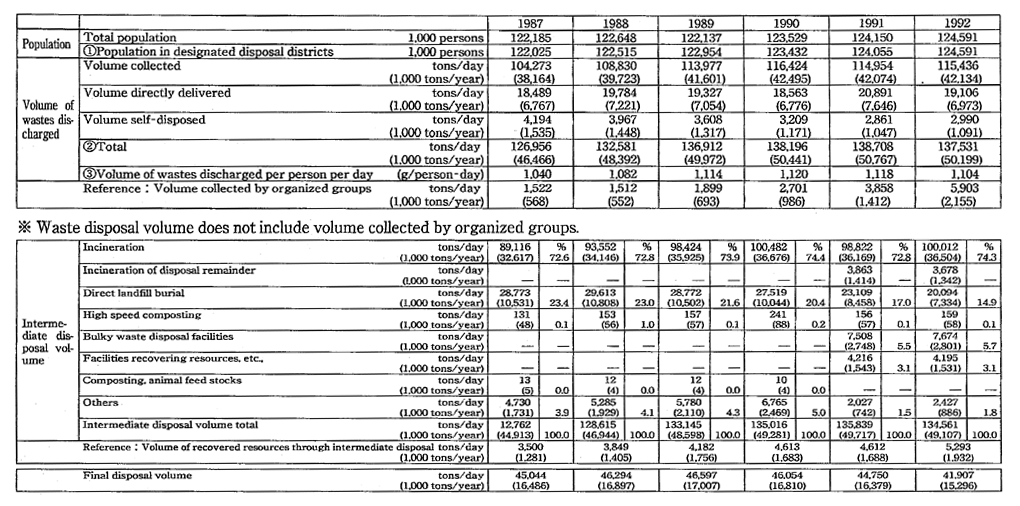
Note:1)=2)/1)
The volume of collection by organized groups is that collcted by neighborhood councils. PTAs. etc,. with cooperation of municipal government.
The volume of recovered resources through intermediate disposal is amout of steel. aluminum and other resources recycled after disposal of resource wastes or bulky wastes.etc.
Since the figures are rounded, the total volume and volume added up may not necessarily match.
The total population includes the foreign population in certain municipalities.
Table 5-4-3 Volume of Industrial Waste Generated (National)
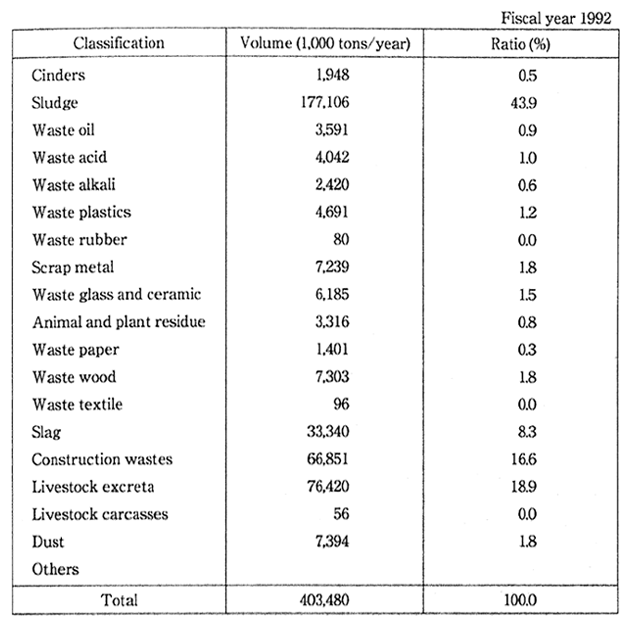
Source:Ministry of Health and Welfare
B. Countermeasures against General Waste
In order to cope with the increase in the amount of general waste generated, the provision of general waste treatment facilities was planned in FY 1995,including garbage treatment facilities, raw sewage treatment facilities and final landfill sites, by means of 191,949 million yen in general account subsidies.
C. Countermeasures against Industrial Waste
Concerning industrial waste, since there has been a steady in-crease in the amount of discharge and in the diversification of its quality, ensuring treatment facilities that will take responsibility for it has come to be difficult, and inappropriate treatment such as illegal dumping is becoming a major social problem. For this reason, in the Ministry of Health and Welfare, within the framework of the principle of the re-sponsibility for treatment lying upon the discharging business, the pro-motion of the provision of treatment facilities by means of public partici-pation is being planned and waste treatment centers based on laws re-lated to the treatment and cleanup of waste are being added in Iwate Prefecture, Oita Prefecture, Nagano Prefecture? Ehime Prefecture, Ka-gawa Prefecture, Niigata Prefecture and Kochi Prefecture, and in FY 1995 Hyogo Prefecture was also designated.
Furthermore, based on laws concerning the promotion of the provision of specially designated facilities concerning the treatment of industrial waste, various measures are being devised in order to prop-erly treat industrial waste. In FY 1995, in addition to recognizing the provision plan concerning theSapporo City Recycling Complex Pro-ject,project promotion has been carried out by means of the industrial waste treatment project promotion foundation, such as business start-up assistance and ensuring obligations with respect to projects to mod-ernize and raise the level of industrial waste treatment facilities.
Concerning policies to rehabilitate the present condition of sites where illegal dumping has occurred, there has also been study concern-ing the proper government measures, private compensation liability, ex-pense burden, etc., and an interim arrangement has been implemented.
In addition, to study information related to industrial waste, sur-veys of the state of the installation of facilities and the state of govern-ment measures, as well as surveys of the state of the treatment of indus-trial waste discharge, have been carried out.
Furthermore, in FY 1991 the state of government measures was that there were 56,914 cases of on-site inspection, 12,140 cases of report collection, 72 cases of the cancellation or temporary suspension of an in-dustrial waste treatment business permit and 17 cases of an order to take action or an order to improve. In the Ministry of International Trade and Industry various types of research and surveys have been carried out that are necessary for future industrial waste treatment and resource reclamation countermeasures. Furthermore, in order to pro-mote resource reclamation from waste, assistance has been given to various resource reclamation projects such as research concerning scat-tered resources and the demonstration facility of the Green Japan Cen-ter foundation.
At the Ministry of Agriculture. Forestry and Fisheries, financial assistance measures have been taken with respect to the establishment by agricultural groups of treatment facilities for plastic after its initial use, and to the study and demonstrations in order to develop and com-mercialize technology for the appropriate treatment of plastic after its initial use in horticulture.
Furthermore, in the Fisheries Agency, the development of fish-ing tackle that uses biodegradable plastic in order to reduce the harm-ful influence of lost fishing tackle on the ocean environment was imple-mented, and the requisite research was carried out for the construction of a recycling system to provide for the effective use of fishing industry materials that can no longer be used, such as FRP fishing boats.
D. Promotion of the Provision of Wide Area Treatment Centers
In large metropolitan areas, in order to handle the demand to en-sure a wide-area final disposal site that handles a metropolitan district as one region, the Ministry of Health and Welfare and the Ministry of Transport have planned the promotion of the Wide Area Waste Recla-mation Disposal Site Plan (called the Phoenix Plan). In the Osaka Bay area, the Osaka Bay Wide-area Seaside Environment Preparation Cen-ter, in addition to continuing to proceed with the construction work of a wide-area treatment plant, accepting waste and carrying out land recla-mation work, has carried out the preparations for deciding on the next plan.
In the Tokyo Bay area, the Ministry of Health and Welfare and the Ministry of Construction in April 1987 finalized the basic concept of the Tokyo Bay Phoenix Plan and presented it to the local government entities concerned. Study is continuing in the related groups concerning the wide-area treatment of waste. The Ministry or Health and Welfare is continuing to carry out investigations concerning the preparation of a wide-area treatment plant in the Tokyo Bay area,,and basic surveys and foundational research have been carried out concering the Chubu area and northern Kyushu area also.
E. Environmental Considerations in Waste Treament
In order to provide for the appropriate use of a land site,while preventing the environmental pollution attributable to the land site of a final disposal site for waste,the basic direction of land site management was set forth in November 1988 based on a joint notice by the Environ-ment Agency and the Ministry of Health and Welfare. In the Environ-ment Agency,as part of the investigation concerning the rationalization of the management of a land site,a survey was carried out related to in-creasing the level of a final disposal site's groundwater pollution preven-tion technology. Furthermore,from among the technologies related to final disposal sites that have been developed at the present time,evalu-ations have been carried out concerning those that 'an be recognized as having an environmental conservation effect. A survey of the actual situation was carried out regarding a stable final disposal Kite in order to study a new system for the appropriate disposal of waste,and a survey was also carried out for the purpose of promoting the popularization and development of higher level technology. Furthermore,in order to provide for the reduction of the burden on the environment and a re-duction of the amount of waste,in addition to carrying out research and various popularization and education projects Concerning the promotion of recycling,because an appropriate standard,from the standpoint of environmental conservation,has not been established at the present time for the recycling of waste,a survey has been carried out in order to decide on guidelines for environmental conservation concerning the recycling of waste.
In the Ministry of Transport,in FY 1995. as a waste treatment countermeasure for harbors and bays,assistance was implemented with respect to the provision of waste product landfill sea walls in 39 ports and one bay,with project expenditures of about 538 billion yen (about 12.5 billion yen of which came from the national Government), while assistance was also carried out in general ocean areas with re-spect to the provision of waste oil treatment facilities and to a garbage and oil recovery project. Furthermore,in order to promote the recy-cling of resources,a project (called Super Phoenix) was started in FY 1994 to effectively make use,over a wide area,of dirt that occurs due to construction in the Tokyo metropolitan area as a resource for harbor construction nationwide,and in FY 1995 the acceptance of dirt gener-ated by construction was implemented at Hiroshima Harbor,Kure Har-bor and Kochi Harbor. Furthermore,in the Ministry of Construction, while taking environmental conservation into consideration,sewage system projects have been implemented that constructively make use of recycled materials and the use of sewage sludge in green belts and agricultural areas,and as building material.
Furthermore,in the Ministry of Health and Welfare,projects have been implemented in the metropolitan areas of large cities in order to systematically provide,over a wide area,facilities to melt the avail-able incinerated ash,etc.,and make it into a raw material,with the aim of prolonging the life of final disposal sites.
F. Prevention of the Scattering of Empty Cans
The situation is such that the quantity of beverage cans pro-duced has rapidly increased. In 1981,there were about 10 billion cans, but in 1994,there were over 37.1 billion cans. Some of these empty bev-erage cans are scattered on highways,beaches and rivers and have be-come a problem from the viewpoint of environmental beautification. The Environment Agency,as a result of a survey conducted in about 700 cities,towns and villages nationwide in FY 1993,was not able to see an improvement in the state of the littering,and the situation has been worsening at generally the same level for the past several years.
Various measures have been carried out from several stand-points to prevent the scattering of empty cans. In local government en-tities,various measures have been devised corresponding to the actual circumstances of the respective regions,and,in addition to enacting the main principles and ordinances concerning the prevention of empty can scattering,campaigns have been undertaken to prevent littering and to strengthen cleanup-in some local government entities by making use of empty can recovery machines,while other examples can be seen in the recovery of empty cans by the introduction of issuance of subsidy cou-pons that can be exchanged for book gift certificates,etc.,when a cer-tain number have been collected,as well as in the institution of deposit systems,etc.
Nationally,based on an understanding in theEmpty Can Prob-lem Liaison Council,composed of the 11 ministries and agencies con-cerned,besides planning the enhancement of popularization and educa-tional activities,the Environment Agency and the Ministry of Health and Welfare have called on local government entities to establishEnvi-ronment Beautification Movement Dayand plan to promote the posi-tive action of all citizens in order to extensively beautify the environ-ment,including preventing the scattering of empty cans.
Section 5. Measures for Environmental Risk of Chemical Substances
1. Promoting Safety-related Policies for Chemical Substances
(1) The Law Concerning the Examination and Regulation of the Manufacture,etc.,of Chemical Substances
TheThe Law Concerning the Examination and Regulation of the Manufacture,etc.,of Chemical Substances(hereafter called the Chemical Substances Control Law) was enacted in October 1973. In accordance with this law,new substances were submitted to inspection-called the pre-evaluation of new chemical substances - for low biode-gradability,high bioaccumulation and chronic toxicity prior to their pro-duction or import. If new chemical substances came under all three categories,they were classified as Specified Chemical Substances and were subject to regulations on production,importing and usage. The law was amended in May 1986,reclassifying the conventional Specified Chemical Substances as Class I Specified Chemical Substances and clas-sifying substances with low biodegradability and suspected chronic tox-icity,but not high bioaccumulation as Designated Chemical Substances. Steps are taken to monitor production volume and to conduct toxicity tests when health hazards may occur resulting from environmental pol-lution affecting a large area caused by certain Designated Chemical Substances. If the toxicity test results prove positive,the compounds are reclassified as Class II Specified Chemical Substances,obligating the manufacturer to comply with technical guidelines in handling the sub-stances and provide labeling for environmental protection. These com-pounds are also subject to regulations on production and import when deemed necessary (Fig. 5-5-1).
The notification of new chemical substances are submitted to the Minister of Health and Welfare and the Minister of International Trade and Industry. During 1995,notifications were submitted for 296 sub-stances. As to investigation of the safety of existing chemical sub-stances,the Ministry of International Trade and Industry is conducting tests on the biodegradability and bioaccumulation of chemical sub-stances and the Ministry of Health and Welfare is conducting tests on toxicity screening ((i) repetitive dose toxicity over 28 days with respect to mammals,(ii) reverse mutations with respect to microbes,(iii) chro-mosomal abnormalities with respect to mammalian cell cultivation), chronic toxicity,etc.; while the Environment Agency is conducting sur-veys on concentrations of chemical substances in the environment. As of December 1995,9 substances have been designated as Class I Speci-fied Chemical Substances and 23 substances have been designated as Class II Specified Chemical Substances,while chloroform and other sub-stances totaling 159 have been classified as Designated Chemical Sub-stances.
Fig. 5-5-1 Regulatory System for Chemical Substances under the Chemical Substances Control Law
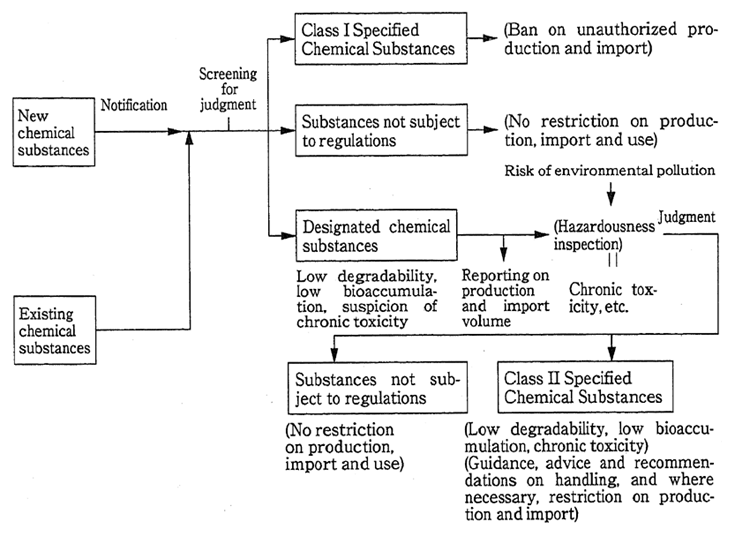
(2) Measures by the Ministries and Agencies Concerned
To investigate the safety of existing chemical substances,the Min-istry of International Trade and Industry conducts tests on biodegrad-ability and bioaccumulation. As of the end of FY 1995,safety tests were conducted on 1071 substances. In addition to conducting tests,the de-velopment of new testing methods are under way to speed up the proc-ess. In order to inspect the safety of existing chemical substances,the Ministry of Health and Welfare is implementing toxicity testing meth-ods (including the screening toxicity and chronic toxicity tests of chemi-cal substances in chronological sequence as well as animal test substitu-tion methods) and research and development concerning evaluation. Furthermore,increasing the efficiency of the inspection of new chemi-cal substances and the safety inspections of existing chemical sub-stances has to be planned,and research is proceeding concerning the in-troduction of the structural activity relationships (SAR) regarding the toxicity of chemical substances.
The Environment Agency has been conducting research on the existing amount of chemical substances in the environment since FY 1974. Several tens of thousands of substances are said to be present in the environment. To conduct systematic research and effectively evalu-ate the safety of such a vast number of substances,the Agency under-took the first General Inspection Survey of Chemical Substances on En-vironmental Safety for the 10 years up through FY 1988.
During the 10-year period,changes in production activities,life-styles,the rising potential of pollution from new technology,and the need for more efficient testing methods to keep in step with the pace of technological advance have made it necessary for the Agency to adopt new measures. In May 1988,the Expert Committee on Chemicals Satety of the Environmental Health Committee,Central Council for En-vironmental Pollution Control submitted suggestions on the future of the General Inspection Survey on Environmental Safety,which con-tained the following main points; (i) an expansion of the list of sub-stances to be surveyed,(ii) a selection of the substances to be tested through a thorough evaluation process called Prediction of the Chemi-cal Fate in the Environment,and (iii) the reinforcement of the content of the surveys by increasing the number of substances to be surveyed while shortening the survey period. Based on the Expert Committee's suggestions,the second General Inspections Survey of Chemical Sub-stances on Environmental Safety began in 1989. The outline of the Gen-eral Inspection Surveys is shown in Figure 5-5-2.
In FY 1995,environmental surveys,ecological effect test surveys, the monitoring of water and bottom sediment quality,and the monitor-ing of wildlife were conducted in accordance with the above outline on chemical substances.
Fig. 5-5-2 Outline of General Inspection Survey on Chemical Substances
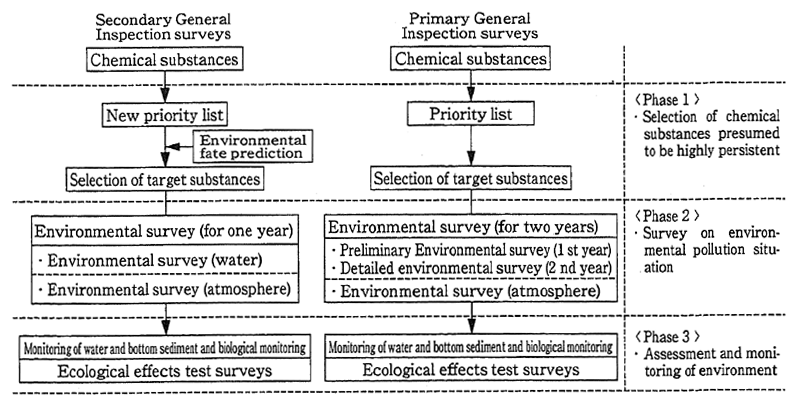
As the usage of chemical substances increases,evaluation meas-ures to assess the environmental risk of multiple chemical substances released into numerous environmental media through all phases of pro-duction and usage must be established,and existing systems must be reviewed to promote environmental conservation. Research and the or-ganization of information on environmental chemical substances as well as research on and the evaluation of comprehensive countermeasures for occurrences of environmental pollution accidents are currently be-ing conducted for this purpose.
Since FY 1995,a project implementing ecological effect tests in order to assess the environmental risks of chemical substances,as well as study and survey concerning systems to grasp the amount of latently toxic chemical substances released into the environment,have been im-plemented.
Furthermore,investigations are being conducted concerning safer treatment technology for PCBs,which have continued to be stored by businesses without progress on full-scale treatment since 1972 when production stopped. Studies of PCBs pollutant treatment methods and treatment methods that do not depend on incineration, such as chemical treatment methods,are progressing.
(3) International Trends
To address environmental pollution caused by chemical sub-stances,in Japan,'Europe,and the United States,laws have been en-acted to require notification for safety evaluations conducted on new chemical substances prior to their production or import. In the United States,in order to minimize the impact of large-scale chemical com-pound accidents,a law was enacted to require factories to establish new emergency procedures and report the inventory of emission volume of toxic chemicals. International organizations such as the OECD,the World Health Organization (WHO),and the United Nations Environ-ment Programme (UNEP) sponsor many active programs,as detailed below,related to countermeasures for chemical substances. Japan is also an active participant in these programs.
A. Programs of the OECD
The OECD establishes safety test guidelines to evaluate new chemical substances (Chemical Substances Safety Test Method) and designates MPDs (minimum pre-marketing sets of data),while promot-ing chemical hazard assessment projects.
The OECD is also inspecting GLP (good laboratory practice),ex-changing information,and examining the economic impact of chemical restrictions. Based on the results of these activities,various measures are drawn up and counseling is conducted.
A clearinghouse program is being carried out,in which safety test information on existing chemical substances,which is collected and stored individually by each country,is distributed to member states.
Furthermore,an international project is being carried out that implements the sharing by each country of the inspections of the safety related to existing chemical substances that are being mass-produced in each country and about which there is little data of the safety. The in-spections of the safety of 648 substances (Japan's allotment is 148 sub-stances) are scheduled to be completed by the year 2000 under this pro-ject. The tests of 33 substances were completed with the first inspection by 1993,and at present,the inspections of 115 substances of the second inspection is starting in order. Furthermore,the investigation to reduce the risk concerning existing chemical substances is being carried out. Concerning lead,a Cabinet proclamation that stipulated the promotion of risk reducing countermeasures was adopted at the meeting of the Directors-General of the Environment Agency in February 1996. In this meeting of the Directors-General of the Environment Agency,a council recommendation concerning the introduction of Pollutant Release and Transfer Register (PRTR) was approved and officially adopted.
B. Programs of the WHO
Based on the approval by the World Health Assembly of WHO plenary session,and in cooperation with the UNEP and International Labor Organization (ILO),the International Programme on Chemical Safety (IPCS) is being implemented with the support of major research laboratories throughout the world. Under this plan,a system is being developed to evaluate the risk that high-priority chemical substances pose and their potential impact on health. Environmental Health Crite-ria are published quarterly for each chemical compound.
C. Programs of the UNEP
The UNEP collects and stores information on the effects that ex-isting chemical substances have on health and the environment. It also manages the International Registry of Potentially Toxic Chemicals (IRPTC),which is conducted to distribute information on the regulatory systems of member states. The UNEP also publishes data profiles,pro-vides a service for answering questions,and publishes the IRPTC Bulle-tin. The London Guidelines,which provide procedures for information exchange regarding the trade of banned or restricted chemical sub-stances,also include the Prior Informed Consent (PIC) from the country to which such substances are shipped. Moreover,the 1995 UNEP Gov-erning Council called on the Executive Director to hold a diplomatic conference in order to adopt PIC as a treaty,with a target date of early 1997,if possible.
However,in the unofficial meeting of April 1994,theEthical Standard Regarding International Transactions of Chemical Products was settled,and in the Intergovernmental Forum on Chemical Safety (IFCS) held at the same month,its promotion was resolved. This stan-dard calls on the private parties participating in international transac-tions in chemical products to make a public commitment to devise vol-untary regulatory countermeasures that agree with the principles of this standard with the objective of reducing the risk to the environment and to people's health due to chemical products.
D. Follow-up of Agenda 21
By integrating the programs sponsored by these international or-ganization,Agenda 21,the action plan adopted at the UNCED (United Nations Conference on Environment and Development) in June 1992, names the following areas as priority programs to be undertaken through global efforts aimed atthe environmentally sound manage-ment of chemicals,including the preventions of illegal international trade of toxic and dangerous products.To conduct follow-ups on the items listed below,the International Conference on Chemical Safety (ICCS) was held in April 1994,and the IFCS was established.
(i) Expansion and acceleration of the international assessment of chemical risks
(ii) Harmonization of classification and labeling of chemicals
(iii) Information exchange on toxic chemicals and chemical risks
(iv) Establishment of risk-reduction programs
(v) Strengthening of national capacities for the management of chemicals
(vi) Prevention of illegal international trade of toxic and dangerous products
(vii) Enhancement of international cooperation
Among these items,concerning the third,theGlobal-scale Infor-mation Network for Chemical Substances(GINC) was started on the Internet with the active support of Japan,as one method for exchanging the chemical substance information possessed by international organi-zations and each country.
(4) Japanese Measures Based on International Trends
Responding to these global activities,ministries and agencies re-sponsible are actively responding to the process of harmonizing the chemical regulations within the OECD and are conducting inspections on the safety of high-production volume chemicals. The reliability of test data is being enhanced while adjustments of domestic legislation are being undertaken to adapt the GLP approved by the OECD Council. Other activities under way are evaluations of the ecological effect as-sessment methods and the gathering and analysis of information on the safety of chemical substances in Japan and abroad.
Efforts to promote the use of the Material Safety Data Sheet (MSDS),which aims at facilitating information exchange among busi-ness concerning the safety of chemical substance,include issuing guide-lines concerning the submission of information regarding the safety of chemical substances.
Furthermore,as a domestically implemented measure of the London Guidelines established by the UNEP,in July 1992 the Export Trade Management Law was revised,and at present,a prior notifica-tion system at the time of export applies to 40 substances.
On the other hand,in order to provide for the promotion of volun-tary chemical substance management in the industrial sector,in April 1995 theJapan Responsible Care Councilwas started and held a liai-son meeting with th six ministries and agencies concerned (the Minis-try of International Trade and Industry,the Environment Agency,the Ministry of Health and Welfare,the Ministry of Transport,the Ministry of Labour and the Fire Defense Agency). Furthermore,in October 1995 the members of this council registered with the UNEP as an enterprise that implements the ethical standard.
(5) International Cooperation
At present many chemical substances circulate in the world and,because they are used and abandoned,the promotion of chemical safety measures under international cooperation has become indispen-sable. In Agenda 21 as well,support to developing countries concerning ensuring chemical safety is mentioned and,in the ministries and agen-cies concerned,technological cooperation is being implemented regard-ing safety evaluation and monitoring the environment for chemical sub-stances.
2. Outline of the General Inspection Survey of Chemical Substances on Environmental Safety
(1) Summary of the Environmental Surveys
In FY 1994,environmental surveys of water were conducted on water and bottom sediment in 55 areas and on fish in 50 areas through-out Japan. Among them,surveys were conducted at all points concern-ing 5 substances,melamine,2-methylpyridine,3-methylpyridine,4-methylpyridine and ethanolamine,as emphasized survey substances, and concerning 17 other substances at 7 to 16 sites. Environmental sur-veys of atmosphere were conducted targeting 17 substances at 18 sites nationwide.
A. Environmental Surveys (Water)
As a result of the surveys this time in the water samples,8 sub-stances (melamine, morpholine, ethylenediaminetetraacetic acid, ni-trilotriacetic acid, 2-methylpyridine, 3-methylpyridine, 4-methylpyri-dine and ethanolamine) in the water among 22 substances, 6 substances (melamine,morpholine,2-methylpyridine,3-methylpyridine,4-meth-ylpyridine and ethanolamine) in bottom sediments among 21 substances, and 5 substances (melamine,o-nitrophenol,2-methylpyri-dine,3-meth-ylpyridine,4-methylpyridine) in fish among 20 substances were de-tected. When the detected concentration and the detected frequency are taken into consideration,they are not in states that suggest an im-mediate problem,but concerning the seven substances with a high fre-quency of detection (melamine,morpholine,ethylenediaminetetraacetic acid,2-methylpyridine,3-methylpyridine,4-methylpyridine and ethano-lamine),conducting environmental surveys after regular intervals from now on and monitoring the changes are thought to be necessary meas-ures (Table 5-54).
Table 5-5-1 Results of Environmental Survey (Water) (Fiscal Year 1994)
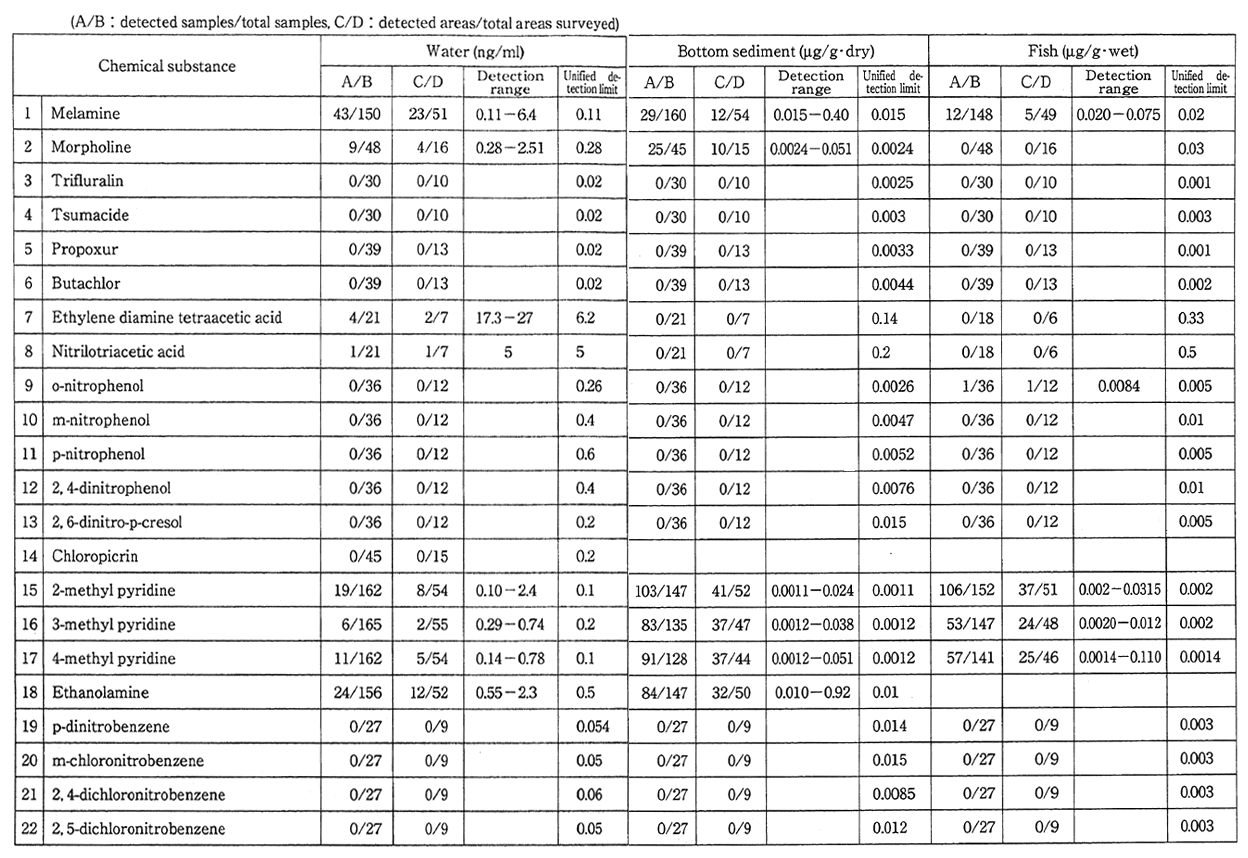
ReferenceChemical Substances in the Environment(FY 1995)
B. Environmental Surveys (Air)
As a result of the surveys this time,among 17 substances,9 sub-stances (2-methylpyridine,3-methylpyridine,4-methylpyridine,ethano-lamine,hexachlorobenzene,pentachlorobenzene,o-nitrophenol,p-nitrophenol,melamine) were detected. In particular,the detected fre-quencies of methylpyridines and nitrophenols were high. Concerning the detected substances,conducting environmental surveys after regu-lar intervals from now on and monitoring the changes are thought to be necessary measures (Table 5-5-2).
(2) Outline of the Results of Water and Bottom Sediments Monitoring
Monitoring water and bottom sediment began as a part of the chemical substances environmental survey in FY 1986. This survey is conducted with a gas chromatography mass spectrometer (GC/MS), which can analyze many kinds of chemical substances simultaneously and accurately. Substances detected in the water and bottom sediment in the environment survey,especially Class I Specified Chemical Sub-stances,are monitored over a long period of time with the GC/MS,and the yearly monitoring on environmental pollution is conducted through tracking the changes of the existing levels of the detected chemical sub-stances.
In FY 1994,the survey was conducted targeting 20 substances at 17 areas nationwide throughout Japan. As a result,the 6 substances of o -dichlorobenzene,m-dichlorobenzene,p-dichlorobenzene,BHT,m-terphenyl and tributyl phosphate were detected in the water,and all 20 substances were detected in the bottom sediment (Table 5-5-3).
When examined as classified by survey area,none of the survey target substances were detected at 7 areas in the water. At each of the other 10 areas,also,only 1 to 4 substances were detected,and the over-all state of detection was low.
The state of detection in the bottom sediment,compared to that in the water,was high overall. From 7 to 19 substances were detected at each of 15 areas. In particular,a majority or more of the substances (11 substances or more) were detected at 8 areas. Furthermore,when the highest values for each survey target substance are examined,it is suggested that the pollution levels at closed inner bay areas are high.
Table 5-5-2 Results of Environmental Survey (Atmosphere) (Fiscal Year 1994)Reference:Chemical Substances in the Environment(FY 1995)
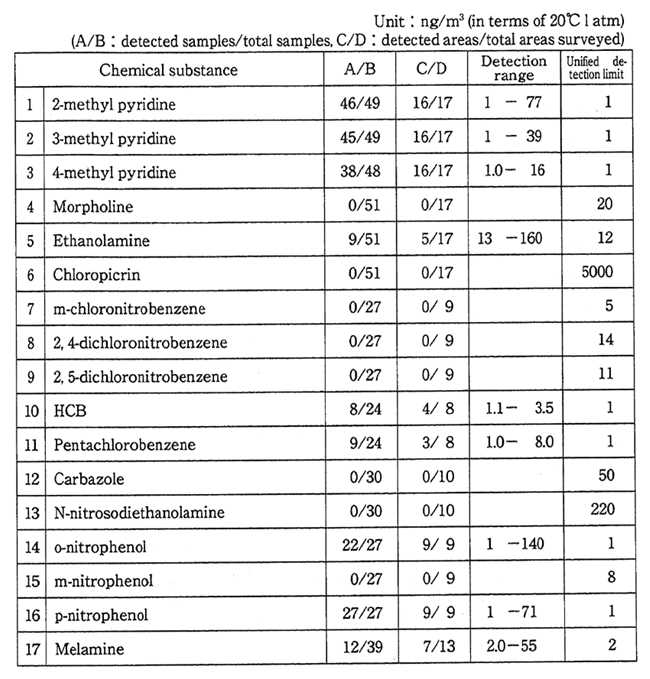
Table 5-5-3 Results of Monitoring of Water Quality and Bottom Sediment (Fiscal Year 1994)
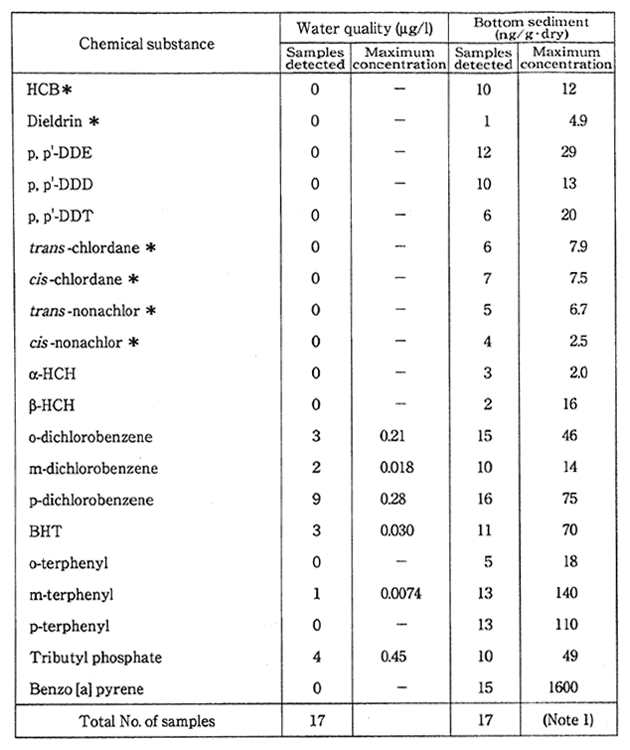
Notes:1. Total number of samples of p,p-DDT of bottom sediment is 16, while that of BHT is 15.
2. The asterisk (*) indicates that the substance is designated as the Class I
Specified Chemical Substances.
Reference:Chemical Substances in the Environment(FY 1995)
(3) Outline of the Results of Bioligical Monitoring
Biological monitoring is conducted on animals such as fish,shell-fish and birds to detect chemical substances classified as Class I Speci-fied Chemical Substances in accordance with theChemical Substances Control Lawand for substances in need of close monitoring,to prevent the worsening of environmental pollution resulting from chemical sub-stances detected in the environment.
In FY 1994,residual concentrations in organisms were surveyed, targeting groups of 7 substances (total of 29 substances) at 20 areas na-tionwide. As a result,each group of substances was detected in some of the organisms. Although the use of these groups of substances,except for the chlorinated benzene types,has been suspended,they still remain over a wide range in the environment,and there is a need for very care-fully tracking of the state of their residue from now on as well.
Environmental pollution by organic tin compounds have been evaluated as follows by the Central Pollution Countermeasures Council, Environment and Health Department,Chemical Substances Expert Committee,along with the inspection survey results for Designated Chemical Substances: (Tributyl tin compounds)
Tributyl tin compounds remain in the environment over a wide area. A trend of improvement can be seen in their pollution level in water. Although the pollution level in organisms is also holding steady or declining,in bottom sediment,it is generally progressing at an un-changing level. The present pollution level is not in a state that can be regarded as an immediate danger,but a high concentration can be seen in parts,and it is necessary to continue monitoring the state of environ-mental pollution in addition to promoting environmental pollution coun-termeasures. (Triphenyl tin compounds)
Triphenyl tin compounds remain over a wide area in bottom sediments and in organisms,but their presence in organisms can be re-garded as in the process of improving. Furthermore,concerning the pol-lution level of water and organisms,although a high state can be seen in parts,it is gradually improving. If the present state of the production of triphenyl tin compounds is considered,further improvement can be ex-pected in the state of pollution,but from now on also,in addition to con-tinuing environmental pollution measures,it is necessary to continue to monitor the state of environmental pollution.
3. Outline of the Results of the Investigation and Survey on Designated Chemical Substances,etc.
The Chemical Substances Control Law was effected in 1987 to in-dude clauses on Class II Specified Chemical Substances and Designated Chemical Substances,requiring notification of planned and actual pro-duction and import volume and to implement other control systems ef-fective both prior to and after production and import.
For the aforementioned Designated Chemical Substances that are potentially harmful to human health due to environmental pollution caused by the substance,a toxicity test is ordered and conducted. If the results indicate that the substance is toxic,it is designated as a Class II Specified Chemical Substances,and prior notification of production and import volume is required. Restrictions in production and imports may be imposed if necessary.
The Environment Agency has been conducting Studies and Sur-veys on the Possibility of Designated Chemical Substances Remaining in the Environment since FY 1988 to determine th residual amounts of the Designated chemical Substances,and particularly the Class II Speci-fled Chemical Substances. Extension of survey areas and upgrading the accuracy of the tests have been undertaken. In addition,since I FY 1990, exposure route surveys,conducted to determine the volume of chemi-cal substances that individual citizens arc exposed to by media,have be-gun. Detected figures have been adjusted to unified detection limits, and the survey is now called Studies on Surveys on the Designated Chemical Substances.
In FY 1994,the Environmental Residue Survey was earn d out, respectively,for 4 substances such as 1,4-dioxane at 34 points concern-ing water and bottom sediment,of 6 substances such as trichioroethyl-ene at 29 points concerning the air,and,the survey of the course of the exposure of 8 substances such as trichloroethylene at 9 points.
4. Outline of the Results of the Follow-up Survey of the Situation of Pollution by Unintentionally Formed Chemical Substances
Because environmental pollution due to chemical substances un-intentionally formed,such as by the process of the incineration of chemi-cal substances and the process of the synthesis of chemical substances. has become a problem,the Environment Agency began theFollow-up Survey on the Actual Situation Regarding Toxic Chemical Substance Pollutionin FY 1985 with the objective of studying the environmental residual properties of unintentionally formed chemical substances in the general environment. The name of the survey was changed in FY 1993 to theFollow-up Survey of the Situation of Pollution by Unintentionally Formed Chemical Substanceand is continuing to be conducted. In FY 1994,the monitoring surveys on dioxins (the general term for polychlo-rinated dibenzo-p-dioxin (PCDD) and Polychiorinated dibenzofuran (PCDF)),which has been continuously conducted since FY 1985,and the environmental surveys on the gross volume of PCBs (Polychlorinated biphenyls ) and on coplanar PCBs were conducted.
As a result of the Survey,the Central Environment Council,En-vironment and Health Department,Chemical Substances Expert Com-mittee evaluated the dioxins as follows:
(Dioxins)
(1) Their pollution in the general environment caused by dioxins have very little possibility of causing effects to human health at present However,dioxins are being detected at low concentration levels,so it is necessary to monitor their pollution continuously.
(2) Elucidation of the pollution mechanism such as sources and envi-ronmental fate of dioxins should take place,together with collection of toxicological information.
(Coplanar PCBs)
The persistence in the environment of coplanar PCBs are thought to originate from release to the environment by PCB products. Since FCBs have been prohibited from use since 1972,and were desig-nated as a Class I Specified Chemical Substance based on the Chemical Substances Control Law in June 1974,and as a Specially Controlled In-dustrial Waste,based on the Law Concerning the Disposal and cleaning of Waste in July 1992,pollution by these substances is unlikely to ex-pand. But,since they are detected with relatively high concentration levels in the environment,it is necessary that their pollution be investi-gated and their transition be monitored.
5. Agricultural Chemical Environmental Risk Countermeasures
(1) The Present State of Agricultural Chemical Pollution
Accompanying the increase in the use of agricultural chemicals after the war,the pollution of food and of the environment due to BHC, DDT,dieldrin,organic mercury preparation,etc.,has become a social problem,but due to the development of low toxicity agricultural chemi-cals stemming from the strengthening of use regulations,and to the de-velopment of science and technology stemming from th revisions of theAgricultural Chemicals Regulation Lawin 1971 and after,chemi-cals with such high toxicities and residual properties hay ceascd to be used and their registrations have lapsed,and the environmental pollu-tion problem due to agricultural chemicals with high residual properties is becoming smaller.
Furthermore,since around 1988 water pollution due to agricul-tural chemicals has become a social problem,but due to the steady op-eration of theProvisional Guidelines for Prevention of Water Pollution by Agricultural Chemicals Used at Golf Linksdecided in May 1990, and to the promotion of various countermeasures in line with the De-cember 1993 Central Council for Environmental Pollution Control re-portMeasures to Preserve the Quality of Water Sources for Public Use,at the present time the problem of environmental pollution due to agricultural chemicals is being improved.
However,originally,the use of agricultural chemicals involved the release into the environment of substances that had the ability to ac-tivate organisms,and from now on,it is necessary to appropriately evaluate safety and to ensure that a harmful effect is not exerted on the human body or the environment.
(2) Promotion of Agricultural Chemical Environmental Risk Countermeasures
In order to prevent pollution due to the use of the agricultural chemicals sold in the country,such chemicals must be registered through an inspection of toxicity and residue according to theAgricul-tural Chemicals Regulation Law,and standards have been established for whether or not registration concerning toxicity and residue is de-ferred for the following:
(i) Matters concerning crop residue
(ii) Matters concerning soil residue
(iii) Matters concerning toxicity with respect to plants and animals of marine industry
(iv) Matters concerning water pollution
Among these,as of January 1996,individual standards have been established concerning 294 agricultural chemicals for the standard con-cerning crop residue,and concerning 63 agricultural chemicals for the standard concerning water pollution,respectively. Concerning the other standard regarding soil residue,a standard common to each agricultural chemical has been established.
Concerning registered agricultural chemicals,viewed from this residual property,when there is anxiety that such chemicals will cause harm to people or animals depending on the method of use,they are designated crop residue agricultural chemicals,soil residue agricultural chemicals or water polluting agricultural chemicals and their use is regulated. The agricultural chemicals thus designated as crop residue agricultural chemicals,etc.,and the agricultural chemicals that are sub-ject to other regulations are set forth in Table 5-5-4.
Furthermore,the provisional guidelines for guidance concerning the prevention of water pollution due to the agricultural chemicals used on golf courses, as well as the water pollution evaluation guidelines for public waters, have been steadily implemented.
Table 5-5-4 Agricultural Chemicals Regulated for Prevention of Environmental Pollution
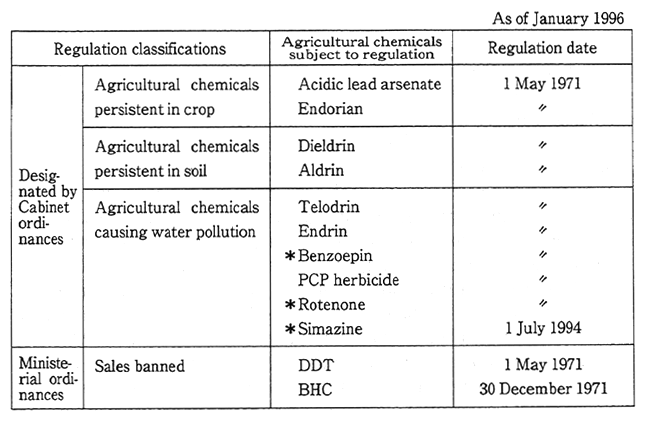
Note:The asterisk * indicates currently designated agricultural chemicals.
In addition, the establishment and promotion of a system to com-prehensively evaluate the risk of agricultural chemicals have been car-ried out; a survey has been implemented concerning the state of the residue of agricultural chemicals in the environment, such as that scat-tered in the air, water pollution and crop residue;and Survey research concerning the ecological influence of agricultural chemicals has been implemented.
Section 6. Environmental Considerations of Technological Development and Coping with New Problems
Accompanying the recent remarkable advances in areas such as microelectronics, new materials, biotechnologies and the so-called high technologies, the industrial structure in Japan has been changing.
It has been pointed out that there are possible environmental hazards that are caused by the development and use of these technolo-gies and that they are different from any existing problems in respect to their sources, emission forms and in their various impacts.
With these changes of circumstance in mind, a thorough study on the possible impact on the environment must be conducted prior to use of such high technologies, so that no environmental problems will be created in the future. On the other hand, it is also important to actively promote the application of such high technologies in the field of environ-mental conservation.
The Environment Agency put together theReport of the Envi-ronmental Technology Councilin April 1987. to specify the basic direc-tion in the field of environmental conservation, corresponding to the progress of high technologies. Among those technologies, the Environ-ment Agency especially focuses on the area related to ICs which have the potential to significantly impact the environment, and has published related technical materials and conductedThe Fact Finding Survey on the IC Industry(FY 1986) jointly with the Ministry of Health and Wel-fare, the Ministry of International Trade an industry, and the Ministry of Labor. As for the area of new materials, the Agency collected and im-proved related technical information, and publishedThe Guidebook Related to Environmental Protection for Engineering Plasticsin De-cember 1989.
As for recombinant DNA technologies,guidelines for safety in the experimental stages and in industrial application stages have been published by th ministries and agencies concerned. Currently,uses of recombinant DNA organisms are being practiced in closed systems and open systems. As for the release of recombinant DNA plants into the environment,23 cases of field trials have been conducted in Japan as of the end of FY 1994. In Japan,confirmation of safety assessment of envi-ronmental impact caused by field trials were conducted concerning re-combinant DNA plants such as tomatoes,rice plants,soybeans and so on,in accordanec with theGuideline for Recombinant DNA Experi-rnentsestablished by the Science and Technology Agency and with the guidelines of the Ministry of Agriculture,Forestry and Fisheries. And cultivation of these plants in general fields has begun as of 1992. As for recombinant DNA animals,experiments have been conducted in conformity with Guideline for Recombinant DNA Experiments in the non-closed and isolated system.
No environmental problems caused by development or use of modern biotechnologies,such as recombinant DNA technologies,have been reported as of today.
In December 1991,the Expert Committee on Biotechnology, which was established within the Planning Department of the Central Council for Environmental Pollution Control to deliberate on biotech-nologies and environmental conservation issues,put together a report and presented it to the Planning Department. The report pointed out that Environmental Impact Assessment should be conducted for indi-vidual programs in relation to the environmental release of genetically modified organisms. According to the report,the Environment Agency reviewed technical matters for the Environmental Impact Assessment of these technologies, and is to continue to investigate on specific admin-istrative measures while giving consideration to the progress of scien-tific knowledge.
In recent years,an environmental restoration technology called bioremediation - a technology to purify soil or undergroundwater con-taminated by toxic substances such as trichioroethylene,by means of microorganisms - has attracted attention,and the Environment Agency is studying the way to use organisms in order to restore the environ-ment with the objective of promoting its sound use.
Furthermore,the National Institute for Environmental Studies has been building its capacities for accommodating the storage of genes of microorganisms which are essential for environmental conservation studies due to their effect on environmental pollution as well as purifica-ion, and for studying the usage and impact of recombinant DNA organ-isms. As a part of activities to promote application of biotechnologies for the field of environmental conservation, the Institute has conducted studies on application of biotechnologies for environmental conservation and their environmental impact
Chapter 6. Harmonious Coexistence between Nature and Humankind
In the Basic Environment Plan, "Harmonious Coexistence" was stated as the long-term objectives and defined as follows. "The atmos-phere, water, soil, wildlife, people and their behavior, mutually affect one another. It is necessary to work on appropriate methods to conserve the environment depending on the special way that it was formed. Such methods include conserving invaluable nature, maintaining and con-serving secondary nature, environmental restoration and wildlife con-servation management. Planning the wise use of nature, while simulta-neously providing places and opportunities to come in contact with it, will ensure a rich exchange between human beings and nature. This Plan shall ensure the maintenance and restoration of a healthy ecosys-tem and a harmonious coexistence between nature and human beings."
As measures for achieving this "Harmonious Coexistence," it has been decided to pursue the coexistence between nature and humankind corresponding to the natural and social characteristics of the national land, the preservation of the biological diversity and the management of wild fauna and flora, and the protection of a ‾sound, abundantly endowed environment in regional development and its use.
Section 1. Symbiosis of Man and Nature Corresponding to the Natural and Social Characteristics of the National Space
1. The Development of Common Policies
In addition to soundly recovering and maintaining diverse eco-logical systems in regions, in order to maintain the abundant contact of man and nature in various places to provide for the symbiosis of man and nature, while being based on the natural and social characteristics of the national space, policies like the following have been implemented.
(1) Conservation of Primeval Nature
A. Conservation of Wilderness Areas
In order to aim for the conservation of natural environments that retain their original characteristic ecosystems without my influence of human activities, the designation of wilderness areas has been stipu-lated for, based on the Nature Conservation Law.
As of the end of FY 1995, the five areas of Onnebetsu-dake, Tokachigawa riverhead, Qigawa riverhead, Minami-Iojirna and Yakushima have been designated. (Figure 6-1-1)
In FY 1995, continuing from FY 1994, survey was carried out to study the actual situation of the Onnebetsu-dake wilderness area.
B. Conservation of World Heritage Area
In addition to deciding on management plans for Yakushima and Shirakami-sanchi, which were inscribed in th world heritage list, proper protection and management are continuingl to be carried out. Furthermore, a core area has been completed, the Yakushima World Heritage Conservation Center., for survey research and th manage-ment of the heritage area in Yakushima, and preparation of the same kind of core area has started in th Shirakami-sanchi (Aomori Prefec-ture).
C. Conservation of the Special Protection Zone of Natural Parks
In order to manage the landscape of National Parks and Quasi-National Parks, when it is particularly necessary, it has been n stipulated that the government can designate spcial protection zone in those ar-eas.
In FY 1995, 1,085 ha was additionally designated in Daisetsuzan National Park.
As of the end of FY 1995, 261,042ha had bee n designated in Na-tional Parks and 66,452ha in Quasi-Nation Parks.
D. Forest Biosphere Reserve
As of the end of FY 1995, in national forest land covering 26 loca-tions and about 320,000ha of forest biosphere reserves, conservation of the rare primeval natural forests unique to particular region and repre-sentation of important forest zones had been established and their proper protection and management had also been implemented.
Fig. 6-1-1 National Parks and Quasi-national Parks in Japan
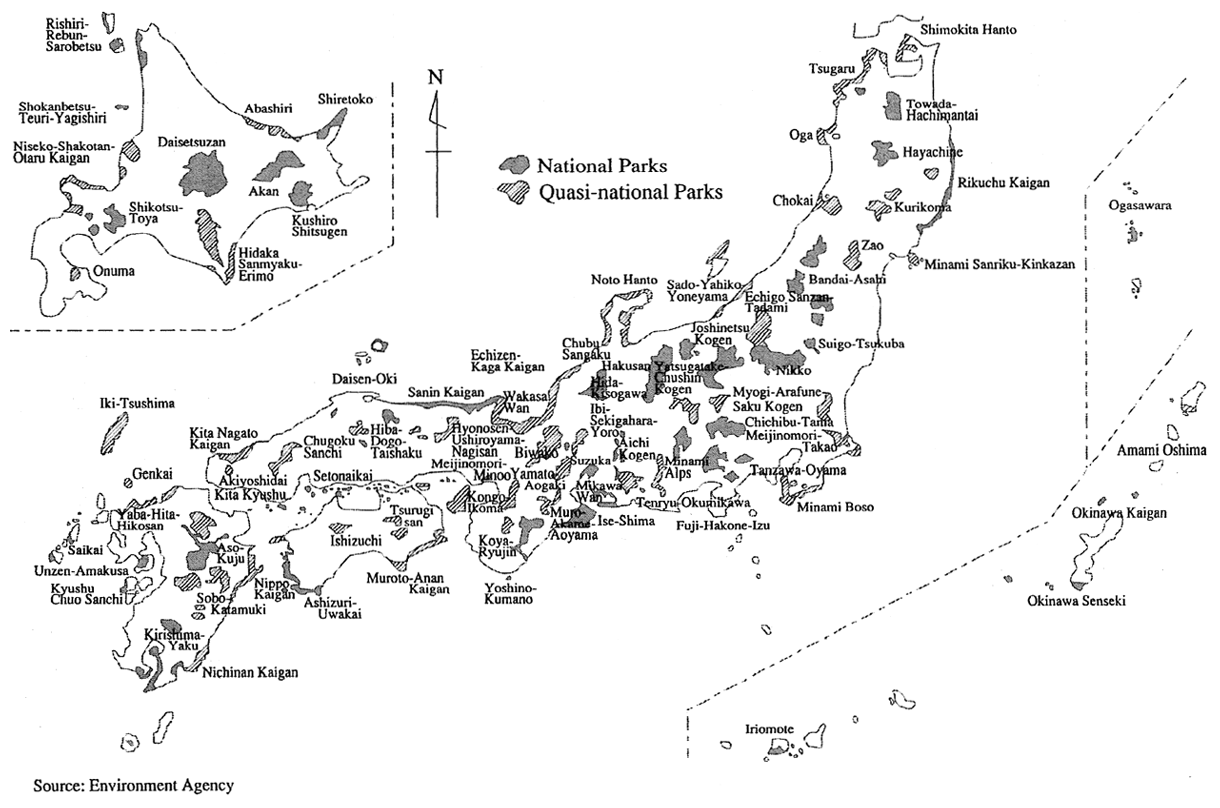
(2) Conservation of Superior Natural Environments
A. Conservation of Nature Conservation Area
In order to provide for the conservation of the natural environ-ment, the government designates regions for which the conservation of the natural environment is particularly necessary from the point of view of natural and social conditions as nature Conservation areas, based on the provisions of th Nature Conservation Law, in districts outside of the wilderness area, and as of the end of FY 1995, 10 regions had been designated.
Furthermore, in prefectures also, based on laws and ordinances it is possible to designate regions for which th conservation of the rele-vant natural environment is particularly necessary, when viewed from the standpoint of the surrounding natural and social conditions, as pre-fectural nature conservation areas, and as of the end of FY 1995, 516 re-gions had been so designated (Table 6-1-1).
Table 6-1-1 Wilderness Areas and Nature Conservation Areas
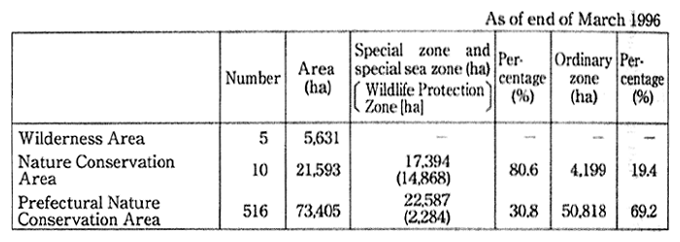
Source: Environment Agency
In FY 1995, in the nature conservation area of the Shirakami-sanchi, a survey was conducted, continuing from FY 1994, to study the present state of the natural environment.
B. Designation of Natural Parks and Reviewing of Park Plan
(A) Designation of Natural Parks
In natural parks there are National Parks designated excellent natural scenic areas that deserve to be representative scenery of Ja-pan; Quasi-National Parks designated superior scenic areas correspond-ing to the scenery of National Parks; and prefectural natural parks des-ignated scenic areas representing the scenery of the prefectures. Up to the present time, many natural parks have been designated. In addition to contributing to the conservation of the natural environment, they play an important role as places for coming into contact with nature such as experiencing the wilds, observing nature and outdoor recrea-tion.
As of the end of FY 1995, Japan's natural parks consisted of 28 National Parks (2,050,000ha), 55 Quasi-National Parks (1,330,000ha) and 303 prefectural parks (l,950,000ha) for a total area of 5,330,000ha occu-pying 14 o of the national land (Table 6-1-1 and Table 6-1-2).
Table 6-1-2 Natural Park Land Area
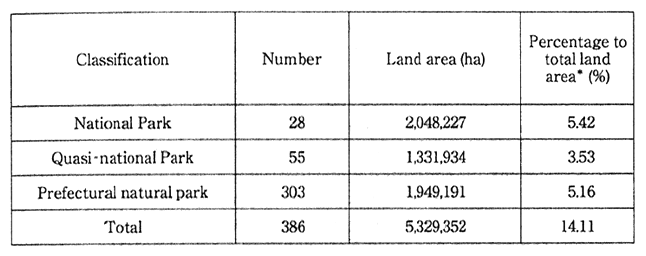
Note: Total land area is 37,781,209 ha (according to October 1993 data from the Geo-graphical Survey Institute )
Source: Environment Agency
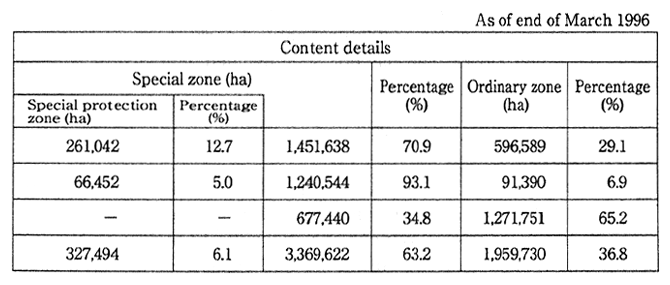
(B) Designation of Marine Park Zone
In order to manage scenery in the ocean, the Director-General the Environment Agency can designate Marine Park Zones on a sea area in National and Quasi-National Parks, in order to manage scenic beauty under the water and to promote recreational use.
In FY 1995 two additional areas were designated in Ashizuri-Uwakai National Park.
By the end of FY 1995,31 zones in National Parks and 30 zones in Quasi-National Parks had been designated, total of 61 zones covering 2,295 ha.
(C) Review of the Park Plan
A park plan has been decided upon in. order to plan for the proper protection and use of the natural parks, and to cope with the so-cial conditions that encompass National Parks, based on a review of the Park Plan which was carried out in FY 1973 as the basis for the strengthening of the protection of nature. Furthermore, concerning parks for which this review has been completed, inspection of the Park Plan is generally implemented every five years. In FY11995. in addition to completing the review of Daisetsuzan National Park and Shikotsu-Toya National Park, the inspection of Ashizuri-Uwakai National Park (Ashizuri region) and Aso Kuju National Park were completed.
Furthermore, concerning park plans of Quasi-National Parks, re-view, corresponding to that of the National Parks, is proceeding at the national and prefectural levels and in FY 1995 review of the Nishichugoku-Sanchi Quasi-National Park was completed.
Furthermore, as for prefectural natural parks, because there are parks for which a park plan has not been decided, guidance was given so that park plans can be decided.
(D) Designation of a Restricted Zone
Accompanying the revision of the Natural Park Law in FY 1990. the Director-General of the Environment Agency can designate a re-stricted zone in the special regions of National Parks and Quasi-National Parks? and in such zones use of horses and vehicles or powered boats and the landing of an airplane have become restricted.
This is for the purpose of preventing harm to the habitats and growing of plants and wildlife due to the driving of snowmobiles, off-road vehicles or motorboats of which popularization in recent years has been conspicuous.
In FY 1995, six zones of two parks have been additionally desig-nated, including Asahidake of Daisetsuzan National Park.
By the end of FY 1995, 25 areas in National Parks and in eight ar-eas in Quasi-National Parks had been designated, total of 33 zones cov-ering 237,922 ha.
C. Conservation of Nature in Natural Parks
(A) Conservation of Scenic Beauty in Natural Parks
a. Controls on Activities in Natural Parks
In order to protect the scenic beauty in the natural parks, special zones, special protection zones and marine park zones are designated (refer to Table 6-1-2). Permission is required from the Director-General of the Environment Agency or the relevant prefectural governor to per-form various kinds of activities in those zones. In giving permission, ef-forts are made for the reasonable protection of scenic beauty, such as with the application of "The Guideline to Assess Various Development Activities in National Park Areas (excluding ordinary zones)."
The number of applications for permission made to the Director-General of the Environment Agency to perform activities in special zones and special protection zones in National Parks is listed in Table 6-1-3.
Table 6-1-3 Applications for Permission of Activities in National Parks (Submitted to the Environment Agency)
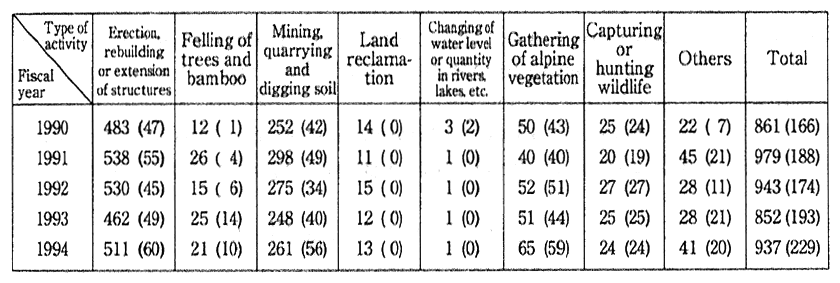
Notes; 1. "Others" includes such activities as changing land shape, etc.
2. Tb numbers within parentheses are the applications for such activities in spe-cial protection zones.
3. The total number includes the number of deliberations by organizations con-cerned of the national government.
Source: Environment Agency
Even in ordinary zones, reports must be made to the relevant prefectural governor when certain activities are to be performed. In the case of golf course development, a policy guideline is formulated for the reasonable protection of the scenery.
b. Studies and Survey on Methods for Management of the Scenic Beauty of Natural Parks
It is crucial that management protection systems thoroughly pre-serve those zones which contain natural features that represent the es-sence of the beauty of a natural park. To facilitate the development of management systems that effectively achieve this, studies and surveys are conducted to more clearly understand the factors which cause changes to the ecosystems in these areas. In FY1995, studies were con-ducted to assist in the development of measures for the conservation of the Kuniga Coast of Oki Island in the Daisen-Oki National Park.
(B) Environment Conservation Measures in Natural Parks
a. Beautification and Cleaning Projects
Rubbish left behind by people visiting natural parks not only spoils the natural scenery of the park, but also causes foul odors and other problems. The Environment Agency is making determined ef-forts to preserve the environment in areas within National Parks popu-lar among visitors, including the promotion of local groups for park beautification, and proving financial assistance for the activities of these groups.
The first Sunday of every August has been designated as Natu-ral Park Cleaning Day, and park clean-ups are organized across Japan.
b. Projects for the Conservation of Special Plants
In order to preserve some species of flora found in National and Quasi-National Parks, protection of their ecosystems is also essential. To this end, the Environment Agency provided financial assistance to local governments for vegetation restoration projects. This type of project was conducted in the Oze Marsh in the Nikko National Park and various other locations.
c. Projects for the Extermination of Acanthaster Planci , etc.
In order to protect the scenic beauty of the marine park zones in the National and Quasi-National Parks where Acanthastar planci and Drupella cornus are spreading, the Environment Agency is providing financial assistance to local governments for projects to exterminate them.
d. Measures to Rationalize the Utilization of Automobiles
In accordance with the Outline on the Rationalization of the Utili-zation of Automobiles in National Parks, produced by the Environment Agency in March 1974, measures are being taken to reduce the damag-ing effects caused by the proliferation of vehicles in natural parks, which include the destruction of pristine environment areas and the ob-struction of the comfortable and safe use of parks. Measures to reduce the impact of vehicles include traffic control, based on the Road Traffic Law and the operation of buses to reduce the volume of private vehicles.
e. Measures for the Conservation of Specified Natural Environment Areas
In order to ensure the adequate protection of valuable ecosys-tems in National Parks, the Environment Agency is continuing to per-form a number of projects and surveys, Examples include studies on measures to conserve the spruce forests in the Odaigahara area of the Yoshino-Kurnano National Park and the environment in the Sarobetsu wilderness area of the Rishiri-Rebun-Sarobetsu National Park.
With the cooperation of the district forest office, environment management projects were carried out in the Shiretoko National Park and the Yakushima (Yakushima Island) area of the Kirishima-Yaku Na-tional Park.
(C) Strengthening of Management Systems
To date, as regards the administration of National Parks, Na-tional Park Offices have been. established in all National Parks and have been supported by local governments and private citizen organizations. in order to cope with the quickening pace of change in the environment surrounding National Parks in recent years, in FY 1995 efforts have also been made to reinforce National Park management systems.
a. National Park and Wildlife Offices
National Park and Wildlife Offices perform a wide range of duties, These include protecting and managing the scenic beauty and natural features of National Parks, providing guidance to park custodians, and educating park visitors about the park environment, in addition to of-fices in 11. National Parks, ranger stations have been established in re-gions throughout Japan where National Parks are located. At the end of FY 1995, there were 159 people working at these offices and stations (the so-called "National Park rangers")
Further, management plans are formulated in ord r to carry out management in an appropriate manner in conformity with th actual conditions of each National Park. In FY 1995, management plans were formulated for 16 areas and 11 National Parks, (for example, in Daisetsu-zan National Park).
b. Activities of Private Organizations
(a) The Natural Park Beautification and Management Foundation performs a number of projects, including th promotion of park clean-up campaigns, the maintenance and management (if park facilities, and the creation of nature conservation education campaigns. The Founda-tion conducted projects in 19 areas, including the Kamikochi area of the Chubu Sangaku National Park and Hyonosen area of the Hyonosen-Ushiroyama-Nagisan Quasi-National Park.
(b) The Nature Conservation Volunteer Fund has implemented as-sistance to volunteer groups that carry out activities such as beautify-ing and cleaning National Parks, protecting and surveying wildlife and guidance in National Parks.
(D) Promotion of the Purchase of Privately Own d Land in Order to Protect Nature
The Environment Agency provides subsidies for the purchase of private land by prefectural governments. That scheme can promote protection of domestic rare wild plants and animals in protected are such as habitats, and protection of wild birds and animals in nationally-established bird and animal protection area
The results of the maintenance of areas of scenic beauty in Na-tional Parks and Quasi-National Parks for the past five years are shown in Table 6-1-4. To date, 65 districts, 6,588ha, (project expenses 12,571 mil-lion yen) have been purchased.
Table 6-1-4 Purchases of Privately-owned Land through the Use of Proceeds from Local Government Bonds
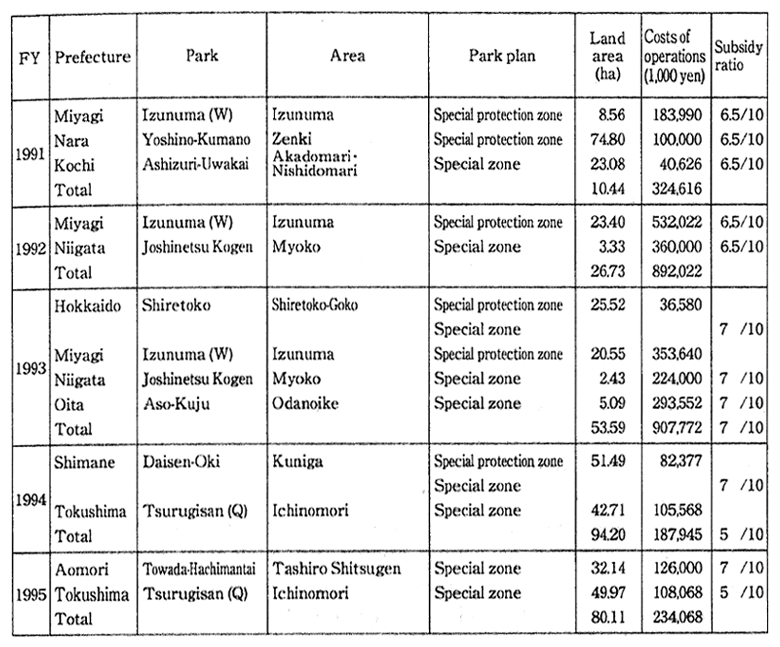
Note: In the column of "Park," (Q) refers to Quasi national Parks, and (W) refers to wild-
life protection areas. All others are National Parks,
Source: Environment Agency
D. Natural Habitat Conservation Areas
The designation of natural habitat conservation areas, which are areas that are Important as the habitat of endangered wild animal and plant species in the country, is being promoted based on the Law for the Conservation of Endangered Species of Wild Fauna and Flora. To date, two places have been designated, the Handa Miyako Bitterling Habitat Protection Area (Tochigi Prefecture, Otawara City) and the Kitadakeso Habitat Protection Area (Ashiyasu Village, Yamanashi Prefecture), and management work such as habitat and growing situation surveys and patrols are being carried out.
E. Wildlife Protection Areas
Wildlife Protection Areas have been established as areas planned for the protection of birds and mammals, striving to improve the habitat environment and forbidding the capturing of birds and mammals, and special wildlife protection areas have been designated in response to still greater need. As of March 1995, 54 national wildlife protection areas (490,000ha), and 3,608 prefectural wildlife protection areas (2,810,000ha), have been established for a total area of 3,290,000ha occupying 9% of the national land area. Furthermore, a total of 260,000ha of special protec-tion areas has been designated in 40 national wildlife protection areas and 575 prefectural wildlife protection areas.
F. Historic Sites, Beauty Spots, Natural Monuments
In order to conserve representative natural environments in Ja-pan, centering on ecosystems and animal and plant species, any interfer-ence with or alteration of the following sites or objects is restricted ; an-cient tombs, shell mounds and castle ruins and other places of historic and scientific value, which are designated as historical sites; gardens and other scenic spots valued for their artistic and aesthetic qualities, which are designated as scenic spots; and geological resources and other records of nature of scientific value, which are designated as natu-ral monuments. As of the end of FY 1995, 1,341 historical sites (of which 57 were special historic sites), 260 beauty spots (of which 28 were spe-cial beauty spots) and 915 natural monuments (of which 72 were special natural monuments) had been designated. Important historic spots were also transferred to public ownership, and various projects, such as provision of facilities, have been carried out in order to enhance the pub-lic's enjoyment of these sites. Measures are being implemented to halt the decline in species of flora and fauna designated as national monu-ments that has accompanied the development of national land in recent years. These include projects to protect these species and their natural habitats and propagation programs to increase their numbers.
G. Protection of Forests
Concerning protection of forests, systematic disposition and proper management from the standpoint of public benefit, including the conservation of the excellent natural environment, are being carried out Furthermore, in addition to establishing 796 places of about 477,000ha that are Forest Biosphere Reserve Forests and. Special Plant and Ani-mal. Habitat Preservation Forests by the end of FY 1995 in National Forests, management for their appropriate protection was carried out.
H. Urban Greenery Conservation
In addition to aggressively promoting the designation of green-ery conservation areas based on the Master Plan of Parks and Open Spaces, concerning greenery conservation districts (excluding suburban greenery special conservation districts), preparation was carried out of the facilities necessary to plan land purchases, at a project cost of 2,982 million yen, and the conservation and use of green areas, at a project cost of 300 million yen.
Among the Tokyo Metropolitan area and the Kinki area subur-ban green area conservation districts, concerning the suburban green area special conservation districts, preparation has been carried out of the facilities necessary to plan the purchase of land, at a projected cost of 740 million yen, and the appropriate conservation and use of green ar-eas, at a projected cost of 100 million yen.
Promotion of the designation of scenic beauty districts from the viewpoint of promoting town revitalization rich in scenic beauty, aiming for the conservation of green areas in cities, was planned.
I. Conservation by Means of the National Trust Movement
Modeled on activities run by the National Trust in the United Kingdom, the Environment Agency sponsors fund-raising campaigns and promotes programs to purchase large areas of unspoiled wilderness and then have these lands managed and administered on a volunteer basis. One example of the many programs currently underway in Japan is the "Tenjinzaki Citizens Conservation Campaign," in Wakayama Pre-fecture.
This type of activity has proven to be particularly rewarding for members of the community, and the Agency intends to further promote similar conservation projects with participation of the general public.
In FY 1995, Non-Profit Nature Conservation Organizations -those non-profit organizations whose primary purpose is to purchase and manage unspoiled areas of wilderness - were recognized as special-purpose corporations for the promotion of the public good and, as such, are eligible for preferential taxation treatment, including exemption from paying taxes on contributions received.
The Environment Agency held a symposium at the 13th National Conference of the National Trust to further explain the aims of the ac-tivities being performed by the National Trust.
(3) Ensuring Commune with Nature
A. Preparation for Use of Facilities
(A) Use of facilities at National Parks and Quasi-National Parks
a. Basic Preparations
In National Parks and Quasi-National Parks that have superior natural environments, while taking these natural environments into consideration, in order to promote safe and comfortable use that re-sponds to the needs of citizens, who are calling for communion with na-ture, basic facilities such as public toilets, parks, campgrounds and paths. have been provided. In particular, among the public toilets and camp-grounds of National Parks and Quasi-National Parks, reconstruction has continued to be implemented concerning facilities that urgently require improvement. The state of preparation of the facilities of National Parks and Quasi-National Parks in FY1995 is seen in Table 6-l-5.
b. Comprehensive Project in Natural Park Core Areas (Green Diamond Plan)
The Environment Agency is carrying out a comprehensive pro-ject in core areas of National Parks and Quasi-National Parks. The pro-ject consists of, in addition to restoration and conservation of nature, field preparation for high-level learning and exploration of nature. The project has been carried out in Kamikochi, Chubusangaku National Park, Ichinose in Hakusan National Park and Oku-Nikko in Nikko Na-tional Park.
Table 6-1-5 Development of Facilities in National Parks and Quasi-national Parks in FY 1995
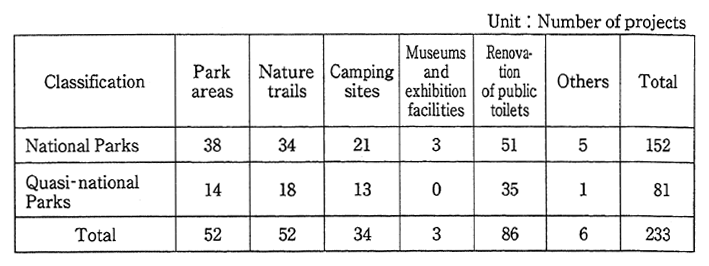
Source : Environment Agency
c. Eco-museum Project
Since FY1995, in the major areas of National Parks and Quasi-National Parks, the preparation of core facilities (eco-museums) for chil-dren to experience communion with nature, to study nature and to com-mune with living things and natural vegetation has begun in three places: the Toro area of Kushiro Shitsugen National Park, the Cho-jabaru area of Aso-Kuju National Park and the Sekigahara area of Ibi-Sekigahara-Yoro Quasi-National Park.
d. Ecology Camp Project
The preparation of environmentally friendly campgrounds in Na-tional Parks and Quasi-National Parks where families can stay for a long time and commune with nature has continued to be implemented.
(B) National Vacation Village
National Vacation Village comprehensively prepares various fa-cilities for becoming familiar with nature, including low-priced and com-fortable lodging facilities, in excellent areas suited for recreation in the natural environments of National Parks and Quasi-National Parks, and as of the end of March 19%, 34 such sites had been offered for use.
Among the National Vacation Village facilities, the national Gov-eminent or local government entities support the public facilities of parks, paths, campgrounds, etc., and the National Vacation Village Coop-eration (a foundation) provides and operates the facilities, such as lodg-ings, lodge, ski lifts, etc., for which a fee is charged.
The changes in the number of users, classified by year, of Na-tional Vacation Villages is seen in Table 6-1-6.
Table 6-1-6 Trend in Number of People Using National Vacation Villages

Source: Environment Agency
(C) Furusato (Hometown) Nature Network
The needs of citizens, which include wanting to spend substan-tial time face-to-face with nature, carrying out various activities in na-ture and visiting areas of natural abundance, are rapidly increasing and diversifying. The practical use of the conservation of familiar natural en-vironments where small animals such as dragonflies and lightning bugs live, and the creation of places where people can relax amid nature and come into contact with living creatures, are being promoted in order to respond to this demand. Specifically, "Furusato (Hometown) Nature Network" is being prepared that will make it possible for citizens to ac-tually feel that they live in symbiosis with nature, selecting projects that match the needs of the regions from a diverse menu; ((i) communi-ties with natural surroundings and culture, (ii) communities for com-munion with nature and native living creatures, (iii) the countryside na-ture trails, (iv) beaches for coming into contact with living creatures, (v) hot spring areas aimed at contact with nature and peace of mind, and,
(vi) national health insurance hot spring areas). (Table 6-1-7)
Preparation was implemented in nine new places and continued in nine places in FY 1995.
Table 6-1-7 List of Centers for Nature Conservation Activities As of March 1996
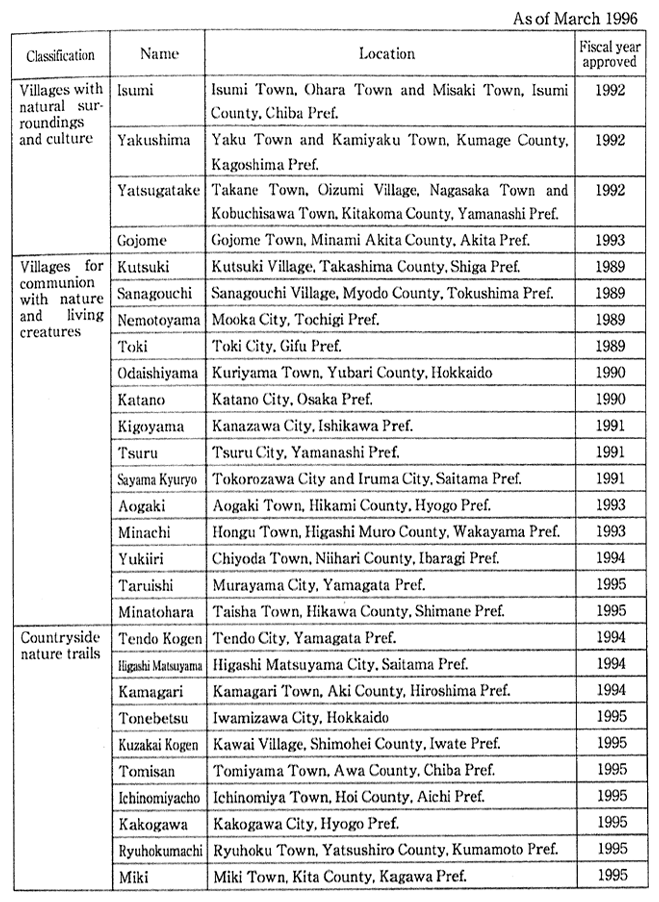
Source : Environment Agency
(D) Long-distance Nature Trail
The long-distance nature trail has been created for the purpose of deepening the understanding of citizens for the protection of nature and for fostering healthy minds and bodies, by means of their extensive visiting of nature and historical landmarks while walking on their own, and preparation has been proceeding since FY 1970 of a long-distance nature trail that organically connects natural parks and cultural assets. Preparation has been carried out white taking into consideration that use should be possible in all seasons and that it should be safe and com-fortable. As of March 1996, it extends for a total length of 18,000 kilome-ters. In FY 1995, in addition to continuing the preparation of th. Tohoku nature trait, preparation was started on the Chubu-Hokuriku nature trail as the seventh nature trail in the nation.
Furthermore, reconstruction was carried out of the facilities of the Tokai, Kyushu, Chugoku, Shikoku and Tokyo metropolitan area na-ture traits that had become old and useless.
The number of users in 1994 was 35,670,000 persons A summary is seen in Table 6-1-8.
(E) Furusato (Hometown) Natural Park Citizens' Recreation Area
The furusato (hometown) natural park citizens' recreation areas are places in prefectural natural parks prepared for urban c'itizens to come into deeper contact with nature through constructively starting activities in nature, stressing learning the way nature and people should harmonize, and preparation of the necessary facilities such as museum display facilities (Furusato natural park center), parks, campgrounds and paths is being carried out. In 1995 preparation was carried out in two areas.